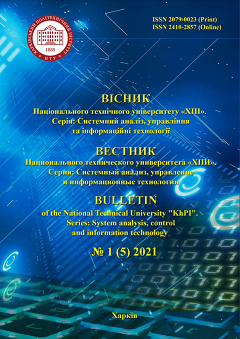OVERVIEW AND ANALYSIS OF METHODS FOR MODELING THE EPIDEMIC DEVELOPMENT PROCESS
DOI:
https://doi.org/10.20998/2079-0023.2021.01.03Abstract
Today, the urgent problem facing humanity is the problem of fighting epidemics and pandemics. One of the ways to solve this problem is the use of mathematical methods for predicting the pandemic process and assessing the impact of measures taken by health authorities to reduce the rate of development of the disease. Based on the analysis of a variety of information sources, the article considers the most effective approach to mathematical and computer modeling of the development of the epidemic on the basis of individually oriented and multi-agent approaches. The analysis of the problem of modeling the development of epidemics on the basis of a multi-agent approach, as well as the possibilities of predicting the course of the epidemiological process is carried out. An example of the structure of a multicomponent simulation model based on the generally accepted verbal model of the spread of viral diseases is given. As an example, the methodology of simulation agent-based modeling using the Any Logic software product of distribution processes 2019-nCoV is considered. The obtained averaged indicators confirmed the main hourly average periods of infection, which were obtained by purely statistical methods. Based on the analysis of published works, the possibilities of managing the development of the epidemic by influencing these factors have been investigated. A relatively simple method of mathematical modeling and forecasting of the epidemic situation has been proposed. It is shown that a timely and adequate forecast is a prerequisite for planning the structure, scale, timing of the necessary measures aimed at preventing epidemics and outbreaks of disease, as well as reducing and eliminating their negative consequences.
Keywords: agent simulation, epidemic, math modeling, pandemic, prognostication, simulation.
References
Ivanov M. V. Matematicheskoe modelirovanie processa pandemii: teoriya i praktika [Mathematical modeling of the pandemic process]. Available at: https://indsi.ru/2020/04/30/ mathematical-modelingprocess / (accessed: 15.11.20).
Mastikhin A. V. Final’nye veroyatnosti dlya markovskih processov epidemii Finalny imovirnosty for Markov processes of the Epidemic. Dis. Dr. Ramat. Sciences. Moscow, 2011. 606 p.
Avilov K. Matematychne modeliuvannia v epidemiolohii yak zavdannia analizu skladnykh danykh. [Mathematical modeling in epidemiology as a problem in the analysis of complex data]. Aviable at: http://download.yandex.ru/company/experience/seminars/KAvilovm atmodelirovanie.pdf (accessed 7.04.2021).
Allen L. J. An Introduction to stochastic epidemic models. URL: http://eaton.math.rpi.edu/csums/papers/epidemic/allenstochasticepid emic.pdf (accessed: 3.04.2021).
Gray A., Greenhalgh D., Mao X., Pan J. The SIS epidemic model with markovian switching. URL: http://strathprints.strath.ac.uk/41322 (accessed: 10.03.2021).
Asatryan M. N., Salman E. R., Boev B. V. Modeliuvannia i prohnozuvannia epidemichnoho protsesu hepatytu V. Epidemiolohiia i Vaktsynoprofilaktyka. [Model and prognosis of the hepatitis B epidemic process. Epidemiology and vaccine prophylaxis]. Moscow: Mir Publ., 2012, no. 1 (62), pp. 49–54.
Boev B. V. Modeliuvannia i prohnozuvannia epidemichnoho protsesu hepatytu A (H1N1). [Modeling the development of the epidemic influenza A (H1N1)]. Epidemiology and Vaccine prophylaxis. 2010, no. 1 (50), pp. 52–54.
Boev B. V., Salman E. R., Asatryan M. N. Zastosuvannia kompiuternoho instrumentariiu dlia prohnozuvannia vodnykhvspyshek hepatytu Atekhnohennoho kharakteru c otsinkoiu efektyvnosti merprotivodeistviia. Epidemiolohiia i Vaktsynoprofilaktyka. [Stagnation of computer tools for predicting water hepatitis indications A technogenic character with an assessment of the effectiveness of measures. Epidemiology and Vaccine prophylaxis.]. 2010, no. 3 (52), pp. 57–62.
Carley K. M., Altman N., Kaminsky B., Nave D., Yahja A. BioWar: A City-Scale Multi-Agent Network Model of Weaponized Biological Attacks. CASOS Technical Report 2004. URL: http://www.casos.cs.cmu.edu/publications/papers/carley_2004_biow arcityscale.pdf (accessed: 17.10.2020)
Coakley S. Formal Software Architecture for Agent-Based Modeling in Biology Ph. D. thesis. Department of Computer Science, University of Sheffield, United Kingdom of Great Britain and Northern Ireland, 2007.
Leonenko V. N., Pertsev N. V. Analiz effektivnosti programm vyiyavleniya individuumov, podverzhennyih kolorektalnom rake, na osnove imitatsionnogo modelirovaniya. [Analysis of the effectiveness of the program for the treatment of individuals with advanced colorectal cancer, based on the simulation model.] Electronic science periodically seen Institute of Management Problems by V.A. Trapeznikov of the Russian Academy of Sciences «Management of great systems». Moscow, IPU RAN Publ., 2011, no. 35, pp. 207–236.
Bailey N. Mathematics in biology and medicine. United Kingdom of Great Britain and Northern Ireland, 1969, 448 p. (Russ. ed.: Є. G. Kovalenko. Matematika v biologii i medicine Moscow, Mir Publ., 1970. 326 p.).
Bellu G., Saccomani M. P., Audoly S., D. L. DAISY: A new software tool to test global identifiability of biological and physiological systems. Computer Methods and Programs in Biomedicine. 2007, vol. 88, no. 1, pp. 52–61.
Krivorotko O. I., Andornaya D. V., Kabanikhin S. I. Sensitivity analysis and practical identifiability of mathematical models of biology. Siberian Journal of Industrial Mathematics. 2020, vol. 23, no. 1, pp. 107–125.
Downloads
Published
How to Cite
Issue
Section
License
LicenseAuthors who publish with this journal agree to the following terms:
- Authors retain copyright and grant the journal right of first publication with the work simultaneously licensed under a Creative Commons Attribution License that allows others to share the work with an acknowledgement of the work's authorship and initial publication in this journal.
- Authors are able to enter into separate, additional contractual arrangements for the non-exclusive distribution of the journal's published version of the work (e.g., post it to an institutional repository or publish it in a book), with an acknowledgement of its initial publication in this journal.
- Authors are permitted and encouraged to post their work online (e.g., in institutional repositories or on their website) prior to and during the submission process, as it can lead to productive exchanges, as well as earlier and greater citation of published work (See The Effect of Open Access).


